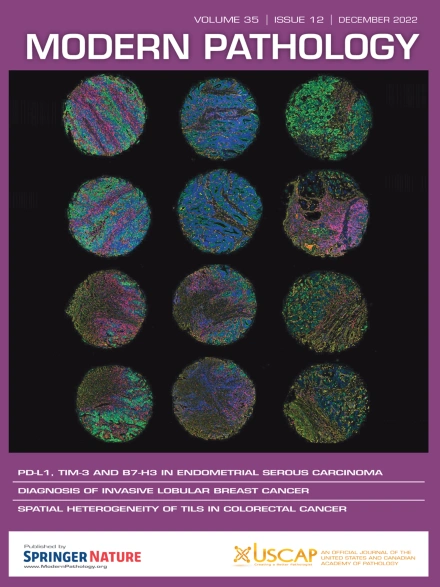Correlation of Histologic Features with Gene Alterations in Pleural Mesothelioma
IF 7.1
1区 医学
Q1 PATHOLOGY
引用次数: 0
Abstract
Histologic features, including architectural patterns, cytologic features, and 2021 World Health Organization nuclear grade have been shown to have prognostic significance in epithelioid diffuse pleural mesothelioma (DPM). Biphasic and sarcomatoid DPM, regardless of morphology, have worse outcomes. These prognostic findings are well established but the correlation of architectural patterns, cytologic features, and nuclear grade with genetic alterations has not been well studied. To investigate relationships between histologic findings and genomic alterations, 128 treatment-naïve DPM specimens (70% epithelioid, 23% biphasic, and 6.3% sarcomatoid) with next-generation sequencing data were retrospectively reviewed. Alterations in BAP1 were the most common genomic alteration (n = 62, 48%), followed by CDKN2A (n = 49, 38%) and NF2 (n = 38, 30%). NF2 alterations were significantly more frequent in biphasic DPM (53% in biphasic vs 25% in sarcomatoid and 22% in epithelioid DPM; P = .005). In epithelioid DPM, TP53 alterations were associated with the presence of prognostically unfavorable histology, including micropapillary or solid architecture, pleomorphic features, and high nuclear grade. Tumors with low tumor-infiltrating lymphocytes (TILs) had a higher rate of BAP1 alterations than tumors with higher levels of TILs (67% vs 30%; P = .002). The findings of this study enhance our understanding of the relationships among prognostically significant histologic and molecular features of DPM and provide preliminary data to support increased integration of these findings in clinical diagnosis of pleural mesothelioma.
胸膜间皮瘤的组织学特征与基因改变的相关性。
组织学特征,包括建筑模式、细胞学特征和2021年世界卫生组织核分级已被证明对上皮样弥漫性胸膜间皮瘤(DPM)具有预后意义。无论形态如何,双相和肉瘤样DPM的预后都较差。这些预后发现已被证实,但建筑模式、细胞学特征和核分级与遗传改变的相关性尚未得到很好的研究。为了研究组织学发现与基因组改变之间的关系,128个treatment-naïve DPM标本(70%上皮样,23%双相和6.3%肉瘤样)与下一代测序数据进行了回顾性分析。BAP1的改变是最常见的基因组改变(n=62, 48%),其次是CDKN2A (n=49, 38%)和NF2 (n=38, 30%)。NF2改变在双期DPM中更为常见(双期53%,肉瘤样25%,上皮样22%;p = 0.005)。在上皮样DPM中,TP53改变与预后不利的组织学存在相关,包括微乳头状或实性结构、多形性特征和高核分级。低肿瘤浸润淋巴细胞的肿瘤与高肿瘤浸润淋巴细胞的肿瘤相比,BAP1的改变率更高(67%对30%;p = 0.002)。本研究的结果增强了我们对DPM预后重要的组织学和分子特征之间关系的理解,并提供了初步数据,以支持这些发现在胸膜间皮瘤的临床诊断中的更多整合。
本文章由计算机程序翻译,如有差异,请以英文原文为准。
求助全文
约1分钟内获得全文
求助全文
来源期刊

Modern Pathology
医学-病理学
CiteScore
14.30
自引率
2.70%
发文量
174
审稿时长
18 days
期刊介绍:
Modern Pathology, an international journal under the ownership of The United States & Canadian Academy of Pathology (USCAP), serves as an authoritative platform for publishing top-tier clinical and translational research studies in pathology.
Original manuscripts are the primary focus of Modern Pathology, complemented by impactful editorials, reviews, and practice guidelines covering all facets of precision diagnostics in human pathology. The journal's scope includes advancements in molecular diagnostics and genomic classifications of diseases, breakthroughs in immune-oncology, computational science, applied bioinformatics, and digital pathology.
 求助内容:
求助内容: 应助结果提醒方式:
应助结果提醒方式:


